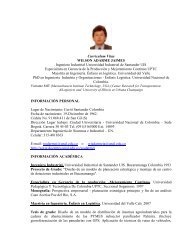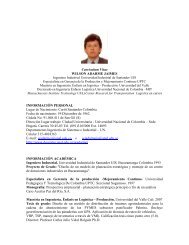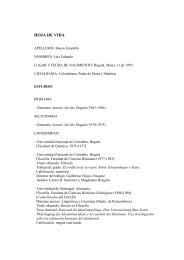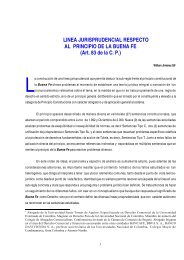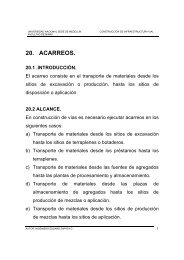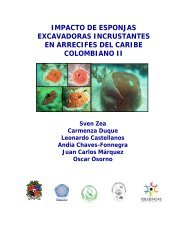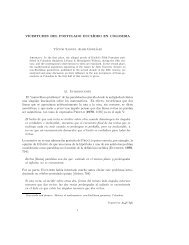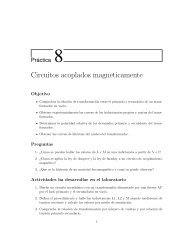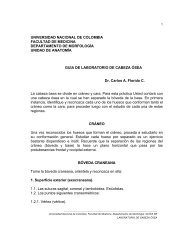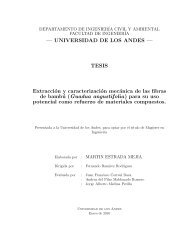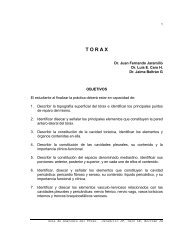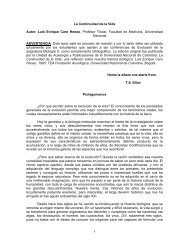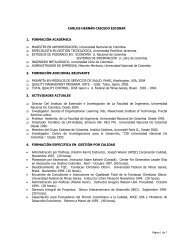Hematopoietic organs of Manduca sexta and hemocyte lineages
Hematopoietic organs of Manduca sexta and hemocyte lineages
Hematopoietic organs of Manduca sexta and hemocyte lineages
Create successful ePaper yourself
Turn your PDF publications into a flip-book with our unique Google optimized e-Paper software.
Dev Genes Evol (2003) 213:477–491<br />
DOI 10.1007/s00427-003-0352-6<br />
ORIGINAL ARTICLE<br />
James B. Nardi · Barbara Pilas · Elizabeth Ujhelyi ·<br />
Karl Garsha · Michael R. Kanost<br />
<strong>Hematopoietic</strong> <strong>organs</strong> <strong>of</strong> <strong>M<strong>and</strong>uca</strong> <strong>sexta</strong> <strong>and</strong> <strong>hemocyte</strong> <strong>lineages</strong><br />
Received: 2 April 2003 / Accepted: 8 July 2003 / Published online: 28 August 2003<br />
Springer-Verlag 2003<br />
Abstract Cells <strong>of</strong> the moth immune system are derived<br />
from <strong>organs</strong> that loosely envelop the four wing imaginal<br />
discs. The immune response in these insects is believed to<br />
depend on the activities <strong>of</strong> two main classes <strong>of</strong> <strong>hemocyte</strong>s:<br />
plasmatocytes <strong>and</strong> granular cells. The fates <strong>of</strong> cells<br />
that arise from these hematopoietic <strong>organs</strong> have been<br />
followed by immunolabeling with plasmatocyte-specific<br />
<strong>and</strong> granular-cell-specific antibodies. Cells within each<br />
hematopoietic organ differ in their coherence <strong>and</strong> in their<br />
expression <strong>of</strong> two plasmatocyte-specific surface proteins,<br />
integrin <strong>and</strong> neuroglian. Within an organ there is no<br />
overlap in the expression <strong>of</strong> these two surface proteins;<br />
Edited by P. Simpson<br />
J. B. Nardi () )<br />
Department <strong>of</strong> Entomology <strong>and</strong><br />
Department <strong>of</strong> Natural Resources <strong>and</strong> Environmental Sciences,<br />
University <strong>of</strong> Illinois,<br />
320 Morrill Hall, 505 South Goodwin Avenue, Urbana,<br />
IL, 61801, USA<br />
e-mail: j-nardi@uiuc.edu<br />
Tel.: +1-217-3336590<br />
Fax: +1-217-2443499<br />
B. Pilas<br />
Flow Cytometry Facility, Biotechnology Center,<br />
University <strong>of</strong> Illinois,<br />
231 Edward R. Madigan Laboratory,<br />
1201 West Gregory Drive, Urbana, IL, 61801, USA<br />
E. Ujhelyi<br />
Center for Microscopy <strong>and</strong> Imaging,<br />
College <strong>of</strong> Veterinary Medicine,<br />
University <strong>of</strong> Illinois,<br />
2001 South Lincoln Avenue, Urbana, IL, 61801, USA<br />
K. Garsha<br />
Imaging Technology Group,<br />
Beckman Institute for Advanced Science <strong>and</strong> Technology,<br />
University <strong>of</strong> Illinois,<br />
405 N Mathews Avenue, Urbana, IL, 61801, USA<br />
M. R. Kanost<br />
Department <strong>of</strong> Biochemistry,<br />
Kansas State University,<br />
104 Willard Hall, Manhattan, KS, 66506, USA<br />
neuroglian is found on the surfaces <strong>of</strong> the coherent cells<br />
while integrin is expressed on cells that are losing<br />
coherence, rounding up, <strong>and</strong> dispersing. A granular-cellspecific<br />
marker for the protein lacunin labels the basal<br />
lamina that delimits each organ but only a small number<br />
<strong>of</strong> granular cells that lie on or near the periphery <strong>of</strong> the<br />
hematopoietic organ. When <strong>organs</strong> are cultured in the<br />
absence <strong>of</strong> hemolymph, all cells derived from hematopoietic<br />
<strong>organs</strong> turn out to immunolabel with the plasmatocyte-specific<br />
antibody MS13. The circulating<br />
plasmatocytes derived from hematopoietic <strong>organs</strong> have<br />
higher ploidy levels than the granular cells <strong>and</strong> represent a<br />
separate lineage <strong>of</strong> <strong>hemocyte</strong>s.<br />
Keywords Hemocytes · Plasmatocytes · Granular cells ·<br />
Hematopoiesis · Insect immunity<br />
Introduction<br />
The immune response <strong>of</strong> caterpillars purportedly depends<br />
on the activities <strong>of</strong> two main <strong>hemocyte</strong> populations,<br />
granular cells <strong>and</strong> plasmatocytes, whose <strong>lineages</strong> have<br />
remained obscure. In addition to the granular cells <strong>and</strong><br />
plasmatocytes that comprise approximately 85–95% <strong>of</strong> all<br />
<strong>hemocyte</strong>s in last instar larvae <strong>of</strong> Lepidoptera (Beetz et<br />
al., submitted; Loret <strong>and</strong> Str<strong>and</strong> 1998), three other classes<br />
<strong>of</strong> <strong>hemocyte</strong>s have been usually recognized on the basis<br />
<strong>of</strong> morphology: pro<strong>hemocyte</strong>s, spherule cells, <strong>and</strong> oenocytoids.<br />
For other insect orders, the terminology applied<br />
to <strong>hemocyte</strong>s is likewise based on morphological features,<br />
but these features <strong>of</strong>ten differ from order to order.<br />
Morphological traits are also <strong>of</strong>ten a function <strong>of</strong> developmental<br />
stage or the media in which <strong>hemocyte</strong>s are<br />
examined, frustrating attempts to compare <strong>hemocyte</strong><br />
classes from different insect orders.<br />
A variety <strong>of</strong> <strong>lineages</strong> has been proposed for the<br />
different classes <strong>of</strong> insect <strong>hemocyte</strong>s. In some proposed<br />
<strong>lineages</strong>, all classes <strong>of</strong> <strong>hemocyte</strong>s arise from a single<br />
population <strong>of</strong> pluripotent stem cells (Lanot et al. 2001;<br />
Yamashita <strong>and</strong> Iwabuchi 2001; Beaulaton 1979; Gupta
478<br />
<strong>and</strong> Sutherl<strong>and</strong> 1966). In other postulated <strong>lineages</strong>, the<br />
different classes <strong>of</strong> <strong>hemocyte</strong>s are derived from at least<br />
two different populations <strong>of</strong> precursors (Gardiner <strong>and</strong><br />
Str<strong>and</strong> 2000, 1999; Lebestky et al. 2000; Rizki <strong>and</strong> Rizki<br />
1984; Shrestha <strong>and</strong> Gateff 1982; Hinks <strong>and</strong> Arnold 1977).<br />
During differentiation, granular cells <strong>and</strong> plasmatocytes<br />
<strong>of</strong> Lepidoptera can be distinguished by their<br />
ultrastructure as well as their labeling patterns with<br />
specific antibodies (Gardiner <strong>and</strong> Str<strong>and</strong> 1999; Willott et<br />
al. 1994). These two classes <strong>of</strong> <strong>hemocyte</strong>s represent two<br />
antigenically distinct <strong>lineages</strong>. The sources <strong>of</strong> these two<br />
different classes <strong>of</strong> circulating <strong>hemocyte</strong>s in larval<br />
Lepidoptera have been traced to (1) hematopoietic <strong>organs</strong><br />
<strong>and</strong> (2) the proliferation <strong>of</strong> other circulating <strong>hemocyte</strong>s<br />
(Ratcliffe et al. 1985). Immunolabeling <strong>of</strong> hematopoietic<br />
<strong>organs</strong> from Spodoptera frugiperda with granular-cellspecific<br />
<strong>and</strong> plasmatocyte-specific antibodies (Gardiner<br />
<strong>and</strong> Str<strong>and</strong> 2000) revealed that about 90% <strong>of</strong> the<br />
<strong>hemocyte</strong>s in each organ are plasmatocytes.<br />
Other findings have supported the proposal that<br />
plasmatocytes, but not granular cells, originate from<br />
these discrete hematopoietic <strong>organs</strong> associated with the<br />
wing discs <strong>of</strong> Lepidoptera (Hinks <strong>and</strong> Arnold 1977; Akai<br />
<strong>and</strong> Sato 1971). Examining populations <strong>of</strong> <strong>hemocyte</strong>s in<br />
situ following cauterization <strong>of</strong> Bombyx wing imaginal<br />
discs <strong>and</strong> their associated hematopoietic <strong>organs</strong>, Nittono<br />
(1964) observed a marked reduction in pro<strong>hemocyte</strong>s <strong>and</strong><br />
plasmatocytes. Nittono interpreted these results as implying<br />
that the hematopoietic <strong>organs</strong> are the source <strong>of</strong> only<br />
pro<strong>hemocyte</strong>s <strong>and</strong> plasmatocytes. Hinks <strong>and</strong> Arnold<br />
(1977) infrequently observed the presence <strong>of</strong> granular<br />
cells <strong>and</strong> spherule cells in hematopoietic <strong>organs</strong> <strong>of</strong> Euxoa<br />
declarata caterpillars, but they concluded that these<br />
particular cells were derived from the hemolymph <strong>and</strong><br />
did not arise intrinsically. The granular cells <strong>and</strong> spherule<br />
cells were always found in those regions <strong>of</strong> the organ<br />
from which other <strong>hemocyte</strong>s had entered the hemolymph<br />
by passing through openings in the organ’s basal lamina.<br />
Although these findings support the view that hematopoietic<br />
<strong>organs</strong> represent aggregations <strong>of</strong> stem cells that<br />
populate the larval hemolymph with plasmatocytes (Gardiner<br />
<strong>and</strong> Str<strong>and</strong> 2000; Hinks <strong>and</strong> Arnold 1977), other<br />
authors have proposed that both granular cells <strong>and</strong><br />
plasmatocytes arise from hematopoietic <strong>organs</strong> (Yamashita<br />
<strong>and</strong> Iwabuchi 2001; Beaulaton 1979).<br />
For <strong>M<strong>and</strong>uca</strong> <strong>sexta</strong>, the cells <strong>of</strong> hematopoietic <strong>organs</strong><br />
have been characterized using a variety <strong>of</strong> approaches. At<br />
the ultrastructural level a few cells with the distinctive<br />
features <strong>of</strong> granular cells have been identified at the<br />
surface <strong>of</strong> the organ. Immunolabeling the cells <strong>of</strong><br />
hematopoietic <strong>organs</strong> with plasmatocyte-specific <strong>and</strong><br />
granular-cell-specific markers has also been used to<br />
establish the fate <strong>of</strong> these cells at a given stage. Both<br />
electron microscopy <strong>and</strong> antibody labeling have shown<br />
that granular cells are either (1) located on the outer<br />
surface <strong>of</strong> the basal lamina that delimits cells within the<br />
organ from the surrounding hemolymph or, (2) in some<br />
instances, they are found just beneath this surface at<br />
places where the basal lamina is disrupted. By culturing<br />
hematopoietic <strong>organs</strong> in the absence <strong>of</strong> hemolymph, the<br />
fate <strong>of</strong> individual cells derived from these <strong>organs</strong> can be<br />
traced with specific antibody markers for plasmatocytes<br />
<strong>and</strong> granular cells.<br />
Materials <strong>and</strong> methods<br />
Rearing <strong>and</strong> staging <strong>of</strong> larvae<br />
All insects were reared on st<strong>and</strong>ard artificial diet under constant<br />
temperature (26C) <strong>and</strong> photoperiod (18 h light:6 h ark). Each<br />
larval stadium (L) is designated with a number (e.g., L5). Day 0<br />
(d0) <strong>of</strong> a stadium marks the molt from the previous stadium. Each<br />
subsequent day (n) <strong>of</strong> a stadium marks 24x(n) hours after the molt<br />
from the previous stadium. Larvae were staged according to several<br />
easily recognized developmental l<strong>and</strong>marks: the molt from the third<br />
stadium (L3) to the fourth stadium (L4d0); the molt from the fourth<br />
stadium (L4) to the fifth stadium (L5d0); <strong>and</strong> the initiation <strong>of</strong> the<br />
w<strong>and</strong>ering stage (L5d5) with its unique morphological <strong>and</strong><br />
behavioral features.<br />
Sections for light <strong>and</strong> electron microscopy<br />
Wing imaginal discs <strong>and</strong> surrounding hematopoietic <strong>organs</strong> were<br />
removed with overlying larval integument from carefully staged<br />
larvae <strong>and</strong> dissected in Grace’s tissue culture medium (Invitrogen).<br />
Organs were separated from the adjacent discs with fine tungsten<br />
needles <strong>and</strong> transferred to primary fixative <strong>of</strong> 2.5% glutaraldehyde<br />
<strong>and</strong> 0.5% paraformaldehyde dissolved in a 0.1 M cacodylate buffer<br />
containing 0.18 mM CaCl 2 <strong>and</strong> 0.58 mM sucrose (Tolbert <strong>and</strong><br />
Hildebr<strong>and</strong> 1981). After several rinses in the cacodylate buffer<br />
containing only sucrose <strong>and</strong> CaCl 2 , tissues were post-fixed in the<br />
same buffer containing 2% OsO 4 in place <strong>of</strong> aldehydes. Tissues<br />
were once again rinsed in cacodylate buffer <strong>and</strong> dehydrated in a<br />
series <strong>of</strong> ethanol concentrations (10–100%) before final infiltration<br />
with propylene oxide <strong>and</strong> Medcast resin.<br />
Sections (1–2 m) for light microscopy were cut with a Reichert<br />
Ultracut E, arranged on glass slides, <strong>and</strong> stained with 1% toluidine<br />
blue in a 1% borax solution. Sections for electron microscopy were<br />
viewed with a Hitachi 600 at 75 kV.<br />
Immunolabeling<br />
Following a half-hour fixation with 4% paraformaldehyde dissolved<br />
in phosphate-buffered saline (PBS, pH 7.4), tissues were<br />
rinsed several times with PBS <strong>and</strong> then transferred to blocking<br />
buffer (PBS +3% normal horse serum or 10% normal goat serum<br />
+0.1% Triton X-100) for at least 30 min. Horse serum was added to<br />
blocking buffer when labeling with horseradish peroxidase (HRP);<br />
goat serum was added to blocking buffer when tissues were labeled<br />
with Texas Red or fluorescein. St<strong>and</strong>ard immunolabeling <strong>of</strong> tissues<br />
has been described in earlier publications (Nardi et al. 1999; Nardi<br />
<strong>and</strong> Miklasz 1989). A 1:10,000 dilution was used for each <strong>of</strong> the<br />
following monoclonal antibodies (MAbs): MS13, MS34, MAb<br />
3B11, <strong>and</strong> MAb 15D11. MS13 <strong>and</strong> MS34 are specific for<br />
plasmatocytes <strong>and</strong> recognize the beta subunit <strong>of</strong> integrin (Levin<br />
et al., in preparation). MAb 3B11 recognizes the cell adhesion<br />
protein neuroglian; in addition to being expressed by a subpopulation<br />
<strong>of</strong> plasmatocytes, neuroglian is expressed by a variety <strong>of</strong><br />
epithelial, neural <strong>and</strong> glial cells (Nardi 1994). MAb 15D11<br />
recognizes the extracellular matrix protein lacunin that is expressed<br />
by granular cells but not plasmatocytes (Nardi et al. 2001). As<br />
controls, tissues were treated with normal mouse serum (1:1,000)<br />
for 12 h in the cold prior to treatment with secondary antibodies.<br />
Whole immunolabeled tissues were mounted in 30% 0.1 M Tris<br />
(pH 9.0) in glycerol.
479<br />
To double-label <strong>organs</strong> with two different mouse monoclonal<br />
antibodies <strong>and</strong> yet ensure that secondary labeling <strong>of</strong> these mouse<br />
monoclonal antibodies did not result in cross reactivity <strong>of</strong> the two<br />
labels, one monoclonal antibody (MAb 3B11) was first labeled with<br />
goat anti-mouse fluorescein according to the above procedure. The<br />
second mouse primary antibody was biotinylated <strong>and</strong> secondarily<br />
labeled with Texas Red-avidin D (Vector Laboratories). After the<br />
fluorescein-labeled secondary antibody was rinsed from tissues, the<br />
<strong>organs</strong> were incubated overnight at 4C with biotin-MS13 diluted<br />
1:1,000 in blocking buffer. Unbound biotinylated antibody was<br />
rinsed from <strong>organs</strong> at room temperature, <strong>and</strong> tissues then were<br />
exposed overnight in the cold to Texas Red-avidin D diluted<br />
1:1,000 in blocking buffer. Several final rinses with blocking buffer<br />
at room temperature preceded mounting <strong>of</strong> tissues on glass slides.<br />
Sections <strong>of</strong> tissues labeled with HRP were prepared from tissues<br />
that had been refixed with the aldehydes <strong>and</strong> 2% OsO 4 as described<br />
in the preceding section. After dehydration <strong>and</strong> infiltration with<br />
Medcast resin, the tissues were sectioned at 1–2 m <strong>and</strong> mounted<br />
on glass slides without staining.<br />
Organ cultures <strong>and</strong> <strong>hemocyte</strong> cultures<br />
Whole hematopoietic <strong>organs</strong> were dissected under sterile conditions<br />
in Grace’s insect culture medium (Invitrogen) whose pH had<br />
been adjusted to 6.5 <strong>and</strong> then filter sterilized. Organs adhered to<br />
sterile cover glasses (22 mm 2 ) that were placed on the bottom <strong>of</strong><br />
small Falcon culture dishes (35”10 mm) containing Grace’s<br />
medium (pH 6.5) plus 20% fetal calf serum (Sigma). Cultures<br />
were maintained at 26C in large culture dishes lined with moist<br />
filter paper.<br />
Circulating <strong>hemocyte</strong>s from last instar larvae were added to<br />
culture dishes prepared as described above. As soon as a drop <strong>of</strong><br />
larval hemolymph touched the medium, the blood was swirled, <strong>and</strong><br />
cells were allowed to settle <strong>and</strong> adhere to the glass coverslip for 1 h.<br />
After this culture period, the medium <strong>and</strong> unattached <strong>hemocyte</strong>s<br />
were removed <strong>and</strong> adherent cells were fixed with PBS containing<br />
4% paraformaldehyde for 30 min at room temperature. These fixed<br />
cells on cover glasses were then rinsed several times with PBS <strong>and</strong><br />
later processed for immunolabeling as described earlier.<br />
Confocal microscopy<br />
Whole <strong>organs</strong> that had been double-labeled with fluorescein <strong>and</strong><br />
Texas Red were observed using laser scanning confocal microscope<br />
(LSCM) instrumentation housed <strong>and</strong> maintained by the Imaging<br />
Technology Group at the University <strong>of</strong> Illinois’ Beckman Institute.<br />
Imaging was performed using the Leica SP-2 spectral confocal<br />
instrumentation equipped with a ”20 plan-apochromatic objective<br />
<strong>and</strong> a ”63 plan-apochromatic oil immersion objective. The 488<br />
laser line from an argon laser was selected for excitation <strong>of</strong><br />
fluorescein, while the 543 laser line from a helium-neon laser was<br />
used to excite Texas Red. To minimize overlap <strong>of</strong> emission spectra<br />
for the two fluorochromes, excitation was performed sequentially.<br />
The emission detection ranges for fluorescein <strong>and</strong> Texas Red<br />
labeling were tuned respectively to the following b<strong>and</strong>widths: 500–<br />
535 nm <strong>and</strong> 593–622 nm. Three-dimensional volumetric data sets<br />
consisting <strong>of</strong> multiple optical sections were processed using Leica<br />
Confocal S<strong>of</strong>tware to yield extended focus projections.<br />
Flow cytometry<br />
Larval mesothoracic wing discs along with the adjacent overlying<br />
integument were dissected <strong>and</strong> transferred to Grace’s tissue culture<br />
medium. <strong>Hematopoietic</strong> <strong>organs</strong> were removed intact from the<br />
surfaces <strong>of</strong> these forewing imaginal discs using tungsten needles<br />
<strong>and</strong> watchmakers’ forceps. Each organ was transferred to a separate<br />
siliconized Eppendorf tube containing 500 l maceration solution<br />
consisting <strong>of</strong> glycerin, glacial acetic acid, <strong>and</strong> water (1:1:13). This<br />
mixture completely disaggregates tissues yet maintains the integrity<br />
<strong>of</strong> individual cells (David 1973). Organs remained in this maceration<br />
solution for at least 15 min <strong>and</strong> were thoroughly vortexed<br />
prior to addition <strong>of</strong> 500 l 4% paraformaldehyde dissolved in PBS.<br />
Cells <strong>of</strong> wing imaginal discs from L5d0 larvae were chosen as<br />
examples <strong>of</strong> known diploid cells. At this larval stage, neither<br />
tracheal cells nor <strong>hemocyte</strong>s have colonized the extracellular space<br />
between the two monolayers <strong>of</strong> the wing discs (Nardi et al. 1985).<br />
The cells <strong>of</strong> these wing discs were disaggregated according to the<br />
procedure above.<br />
The disaggregated cells remained in fixative (2% paraformaldehyde)<br />
for 30 min before being centrifuged at 200 g in a swinging<br />
bucket rotor. The cell pellet was washed first with 1.0 ml PBS <strong>and</strong><br />
then with 1.0 ml blocking buffer (PBS +10% normal goat serum<br />
+0.1% Triton X-100). The washed pellet was suspended in 100 l<br />
blocking buffer containing the mitosis marker, rabbit anti-phosphohistone<br />
H3 (Upstate), at a concentration <strong>of</strong> 10 g/ml. Controls were<br />
exposed to 1:1,000 normal rabbit serum. The fixed cells remained<br />
in the primary rabbit antibody for 3 h at room temperature <strong>and</strong> then<br />
were washed twice with 1.0 ml blocking buffer before being<br />
incubated with 15 g/ml fluorescein goat anti-rabbit IgG (Vector)<br />
in 100 l blocking buffer. After the cells had been exposed to<br />
secondary antibody for 2 h at room temperature, they were washed<br />
once with 1.0 ml blocking buffer <strong>and</strong> 1.0 ml PBS <strong>and</strong> stored at 2C<br />
in the dark until analyzed with flow cytometry no more than 2 days<br />
later.<br />
Both the total number <strong>of</strong> cells per hematopoietic organ as well<br />
as the number <strong>of</strong> fluorescein-labeled mitotic cells per organ were<br />
calculated by simultaneously adding a known number <strong>of</strong> 6-m<br />
carmine beads (Molecular Probes, 620 nm emission) to suspensions<br />
<strong>of</strong> macerated hematopoietic <strong>organs</strong>.<br />
To establish the relationship between the class <strong>of</strong> circulating<br />
<strong>hemocyte</strong> (granular cells or plasmatocytes) <strong>and</strong> their ploidy levels,<br />
blood from larvae (L5d0, L5d4, L5d5) was collected in anticoagulant<br />
buffer (AC buffer). To each tube containing 750 l AC buffer,<br />
four drops <strong>of</strong> blood were added, mixed, <strong>and</strong> then fixed with 750 l<br />
4% paraformaldehyde in PBS for 30 min at room temperature.<br />
These fixed, circulating <strong>hemocyte</strong>s were then immunolabeled with<br />
plasmatocyte-specific MS13 <strong>and</strong> granular-cell-specific MAb<br />
15D11 following the procedure outlined for immunolabeling <strong>of</strong><br />
macerated cells from hematopoietic <strong>organs</strong>. Propidium iodide<br />
(1 mg/ml in distilled H 2 O) was added (8% by volume) to<br />
suspensions <strong>of</strong> permeabilized cells in PBS to stain for DNA.<br />
For cell counting <strong>and</strong> analysis <strong>of</strong> labeled cells, a Coulter EPICS<br />
XL-MCL cytometer, equipped with an air-cooled,15-mW argon<br />
laser operating at 488 nm was used. To separate fluorescence<br />
emission <strong>of</strong> fluorescein isothiocyanate (FITC), carmine beads <strong>and</strong><br />
propidium iodide (PI), the following set <strong>of</strong> b<strong>and</strong> pass filters was<br />
used: 525, 620 <strong>and</strong> 675 nm, respectively. To discriminate doublets<br />
when DNA distribution was measured, peak versus integral<br />
fluorescence <strong>of</strong> PI was recorded at the same time.<br />
Results<br />
To establish the fate <strong>of</strong> cells in the hematopoietic <strong>organs</strong><br />
<strong>of</strong> M. <strong>sexta</strong>, a combination <strong>of</strong> approaches has been used:<br />
(a) high-resolution imaging <strong>of</strong> cells that permits visualization<br />
<strong>of</strong> features distinctive for granular cells; (b)<br />
immunolabeling <strong>of</strong> well-permeabilized <strong>organs</strong> with antibodies<br />
that are specific for particular classes <strong>of</strong> <strong>hemocyte</strong>s;<br />
(c) culture <strong>of</strong> isolated <strong>organs</strong> in vitro.<br />
Morphology <strong>and</strong> fine structure <strong>of</strong> hematopoietic <strong>organs</strong><br />
Each hematopoietic organ is draped across a wing<br />
imaginal disc. The inner surface <strong>of</strong> the organ lies adjacent<br />
to the wing disc, <strong>and</strong> the outer surface <strong>of</strong> the organ faces
480<br />
Figs. 1–4 In this series <strong>of</strong> four images, the position <strong>of</strong> the<br />
hematopoietic organ is shown relative to the nearby wing disc,<br />
consisting <strong>of</strong> a peripodial epithelium (p) that surrounds each wing<br />
epithelium (W). Both groups <strong>of</strong> coherent cells <strong>and</strong> clusters <strong>of</strong><br />
noncoherent cells are found in each hematopoietic organ. Most <strong>of</strong><br />
the coherent cells are located near the inner surface <strong>of</strong> the organ<br />
(i.e., adjacent to the wing disc). The magnification is the same for<br />
each image. Tracheoles are indicated with arrows<br />
Fig. 1 On L4d3, a day prior to the molt from the 4th instar to the<br />
5th instar, this lobe <strong>of</strong> the hematopoietic organ lies between the<br />
larval thoracic integument—epithelium (E) + cuticle (C)—<strong>and</strong> the<br />
peripodial epithelium (p) <strong>of</strong> the wing disc<br />
Fig. 2 Immediately after the molt from the 4th instar to the 5th<br />
instar<br />
t<br />
(L5d0), an inner-outer polarity <strong>of</strong> the organ is eviden<br />
Fig. 3 This section <strong>of</strong> an L5d1 hematopoietic organ was cut at the<br />
periphery <strong>of</strong> the wing disc<br />
Fig. 4 By the w<strong>and</strong>ering stage <strong>of</strong> the 5th instar (L5d5), the<br />
organization <strong>of</strong> the hematopoietic organ has changed with the basal<br />
lamina <strong>of</strong> the organ becoming folded <strong>and</strong> convoluted (arrowheads)<br />
the hemocoel (Figs. 1, 2, 3, 4). A basal lamina delimits<br />
the organ with its surface intact on the inner surface <strong>of</strong> the<br />
organ (facing the wing disc) but disrupted in places on its<br />
outer surface that faces away from wing disc (Figs. 6,19,<br />
21). Numerous thin sections <strong>of</strong> <strong>organs</strong> at different times<br />
during the penultimate (4th) <strong>and</strong> last (5th) larval stadia<br />
were cut <strong>and</strong> examined. The architecture <strong>of</strong> hematopoietic<br />
<strong>organs</strong> as well as the fine structure <strong>of</strong> individual cells<br />
within these <strong>organs</strong> <strong>and</strong> on their surfaces are presented in<br />
a series <strong>of</strong> electron <strong>and</strong> light micrographs (Figs. 1, 2, 3, 4,<br />
5, 6, 7, 8, 9, 10, 11, 12, 13, 14).<br />
After the initiation <strong>of</strong> w<strong>and</strong>ering (L5d5) the welldefined<br />
differences between inner <strong>and</strong> outer surfaces <strong>of</strong><br />
<strong>organs</strong> become less evident as the delimiting basal lamina<br />
becomes folded <strong>and</strong> convoluted. Many cells <strong>of</strong> the organ<br />
lose their coherence <strong>and</strong> disaggregate. Some cells engulf<br />
<strong>and</strong> phagocytose one another (Fig. 9). In this respect,<br />
these cells resemble the phagocytic cells also observed in<br />
Drosophila lymph gl<strong>and</strong>s at the w<strong>and</strong>ering stage (Lanot et<br />
al. 2001) or the reticular cells <strong>of</strong> Gryllus, Calliphora, <strong>and</strong><br />
Locusta hematopoietic <strong>organs</strong> that have dual functions <strong>of</strong><br />
hematopoiesis <strong>and</strong> phagocytosis (H<strong>of</strong>fman et al. 1979).<br />
As the hematopoietic organ degenerates at the end <strong>of</strong><br />
larval life, the remaining cells adopt interlocking, attenuated<br />
forms <strong>and</strong> extend numerous fine processes from<br />
their surfaces (Figs. 10, 11). Several days later at<br />
Figs. 5–8 At higher resolution, most noncoherent <strong>and</strong> all coherent<br />
cells <strong>of</strong> hematopoietic <strong>organs</strong> can be distinguished from morphologically<br />
distinctive granular cells. These latter cells are always<br />
located near the periphery <strong>of</strong> each organ<br />
Fig. 5 Noncoherent cells from an L4d3 larva are interspersed with<br />
thin str<strong>and</strong>s <strong>of</strong> basal lamina (arrows)<br />
Fig. 6 A thick basal lamina (arrow) separates coherent cells <strong>of</strong> an<br />
L4d3 organ (lower right) from more peripheral cells, one <strong>of</strong> which<br />
is a granular cell (G) with its characteristic inclusions. Note that this<br />
granular cell lies within a break in the basal lamina (single<br />
arrowheads)<br />
Fig. 7 On L5d0 the thicker outer basal lamina (large arrows) can<br />
be compared with thinner basal laminae (small arrows) that are<br />
found in the interior <strong>of</strong> each organ. A granular cell (G) with<br />
distinctive inclusions lies to the right on the periphery <strong>of</strong> the organ.<br />
T Tracheole<br />
Fig. 8 On L5d3 this coherent mass <strong>of</strong> cells is delimited by<br />
relatively thick basal laminae (arrows) on both inner (top) <strong>and</strong> outer<br />
(bottom) surfaces <strong>of</strong> the hematopoietic organ
481
482<br />
Figs. 9–14 Views <strong>of</strong> hematopoietic <strong>organs</strong> between the w<strong>and</strong>ering<br />
stage <strong>of</strong> the 5 th instar (L5d5) <strong>and</strong> pupation 5 days later<br />
Fig. 9 On L5d5 convoluted basal laminae (arrows) are found<br />
throughout the hematopoietic organ. Basal laminae (b) as well as<br />
cells (c) are being engulfed by phagocytic cells believed to be<br />
granular cells (G)<br />
Fig. 10 On L5d6 remaining cells <strong>of</strong> the organ interlock with long<br />
processes <strong>and</strong> form large, spherical extracellular spaces (S). Cells<br />
extend numerous fine processes (arrows) into these spaces<br />
Fig. 11 The global architecture <strong>of</strong> the L5d6 organ <strong>and</strong> its large<br />
number <strong>of</strong> spherical extracellular spaces are more clearly visualized<br />
at lower magnification
pupation, the cells <strong>of</strong> the organ have lost most <strong>of</strong> their<br />
conspicuous intercellular spaces, <strong>and</strong> their nuclei undergo<br />
condensation <strong>and</strong> adopt highly ramified forms—classical<br />
features <strong>of</strong> apoptotic cells (Figs. 11, 12, 13, 14).<br />
Expression <strong>of</strong> surface proteins by cells<br />
<strong>of</strong> the hematopoietic organ<br />
Fig. 12 Four days later at pupation the conspicuous extracellular<br />
spaces (S) are less numerous <strong>and</strong> cells are showing ultrastructural<br />
features <strong>of</strong> programmed cell death<br />
Fig. 13 A close up <strong>of</strong> a nucleus (N) from a cell <strong>of</strong> a hematopoietic<br />
organ at pupation having the highly ramified form <strong>and</strong> condensation<br />
typical <strong>of</strong> nuclei in apoptotic cells<br />
Fig. 14 The global architecture <strong>of</strong> the organ at pupation showing<br />
its tenuous connection to the pupal epidermis at E <strong>and</strong> the remnants<br />
<strong>of</strong> the spherical extracellular spaces (arrows)<br />
The cells <strong>of</strong> the organ’s inner surface are generally more<br />
coherent <strong>and</strong> densely packed; on the outer surface, the<br />
cells lose their coherence <strong>and</strong> disperse into the hemolymph<br />
(Figs. 1, 2, 19, 21). Most <strong>of</strong> the closely coherent<br />
cells are concentrated near the inner surface <strong>of</strong> the organ,<br />
although a few clusters <strong>of</strong> coherent cells lie near the outer<br />
surface.<br />
All plasmatocytes that have dispersed from the hematopoietic<br />
organ—circulating as well as adherent—immunolabel<br />
with MS13 <strong>and</strong> MS34 (anti-integrins; Levin et<br />
al., in preparation). Cells that express neuroglian are<br />
always coherent cells that usually lie near the inner<br />
surface <strong>of</strong> the organ, whereas cells that express integrin<br />
are found on both inner <strong>and</strong> outer surfaces <strong>of</strong> hematopoietic<br />
<strong>organs</strong> (Figs. 15, 16, 17, 18, 19). Upon becoming<br />
noncoherent <strong>hemocyte</strong>s, the surfaces <strong>of</strong> these particular<br />
cells uniformly express integrin but lose their uniform<br />
surface expression <strong>of</strong> neuroglian.<br />
Cells <strong>of</strong> the organ form a coherent mass segregated<br />
from granular cells <strong>of</strong> the hemolymph by a basal lamina.<br />
Only a few cells <strong>of</strong> the hematopoietic organ immunolabel<br />
with MAb 15D11, a specific marker for granular cells <strong>and</strong><br />
basal laminae. Granular cells are localized to the periphery<br />
<strong>of</strong> the organ where they apparently can transverse<br />
breaks in the basal lamina (Figs. 6, 7, 21). In crosssections<br />
<strong>of</strong> hematopoietic <strong>organs</strong> labeled with MAb<br />
15D11 the basal lamina clearly labels; however, cells<br />
within the organ, with the exception <strong>of</strong> a few at the<br />
periphery, are not immunoreactive (Figs. 20, 21). In<br />
sections examined at high resolution, basal laminae are<br />
found throughout the interior <strong>of</strong> the <strong>organs</strong> that are<br />
thinner than the exterior, enveloping basal laminae<br />
(Figs. 5, 7). None <strong>of</strong> these thinner basal laminae label<br />
with MAb 15D11. The protein lacunin that is recognized<br />
by this MAb (Nardi et al. 1999) is produced by granular<br />
cells but not by plasmatocytes (Nardi et al. 2001).<br />
Although all circulating plasmatocytes immunolabel<br />
with the anti-integrins MS13 <strong>and</strong> MS34, only a small<br />
fraction <strong>of</strong> the cells within the hematopoietic organ<br />
immunolabel with anti-integrin. Those cells <strong>of</strong> hematopoietic<br />
<strong>organs</strong> that label with anti-integrins, however, do<br />
not label with anti-neuroglian (Figs. 22, 23).<br />
Like developing T-cells in the mammalian thymus, the<br />
plasmatocytes that develop within the moth hematopoietic<br />
<strong>organs</strong> probably pass through phases marked by changes<br />
in expression <strong>of</strong> surface proteins (Janeway et al. 2001).<br />
Development within the lepidopteran hematopoietic organ<br />
also seems to be compartmentalized, with differences<br />
in surface protein expression <strong>and</strong> cell cohesion observed<br />
along the inner-outer axis <strong>of</strong> the organ.<br />
Culture <strong>and</strong> mitotic activity <strong>of</strong> cells<br />
from hematopoietic <strong>organs</strong><br />
483<br />
<strong>Hematopoietic</strong> <strong>organs</strong> <strong>of</strong> Lepidoptera are known to be<br />
sources <strong>of</strong> dividing <strong>hemocyte</strong>s (Gardiner <strong>and</strong> Str<strong>and</strong><br />
2000; Akai <strong>and</strong> Sato 1971). The fates <strong>of</strong> cells that arise<br />
from isolated cultures <strong>of</strong> hematopoietic <strong>organs</strong> can be<br />
tracked by marking these cells with antibodies that are<br />
specific for particular classes <strong>of</strong> <strong>hemocyte</strong>s. The markers<br />
can establish the diversity <strong>of</strong> <strong>hemocyte</strong> classes that are<br />
descended from the undifferentiated cells <strong>of</strong> a given<br />
organ.<br />
Cells derived from cultured <strong>organs</strong> in vitro either (1)<br />
adhered <strong>and</strong> spread or (2) remained suspended in culture<br />
medium after dispersing from the hematopoietic organ.<br />
All cells that had dispersed from the organ immunolabeled<br />
with plasmatocyte-specific MS13 <strong>and</strong> MS 34<br />
(Figs. 24, 25), but not with granular-cell-specific MAb<br />
15D11. Cells adhering to the glass <strong>and</strong> plastic substrata<br />
within the culture dish as well as cells that were collected<br />
from the medium were fixed <strong>and</strong> immunolabeled. The<br />
specific immunolabeling <strong>of</strong> all these cultured cells<br />
(adherent <strong>and</strong> nonadherent) with MS13 <strong>and</strong> MS34 (antiintegrins)<br />
provides some <strong>of</strong> the best evidence that only<br />
plasmatocytes are derived from the thoracic hematopoietic<br />
<strong>organs</strong>.<br />
Mitotic cells are abundant throughout each organ<br />
(Figs. 26, 27). Some mitotic cells express the surface<br />
protein neuroglian (Fig. 28); however, cells <strong>of</strong> the<br />
hematopoietic organ that express integrin <strong>and</strong> are dispersing<br />
were never observed to express the mitotic marker<br />
in <strong>organs</strong> from each <strong>of</strong> the four L5d3 <strong>and</strong> four L5d5<br />
larvae that were doubly immunolabeled (Fig. 29).<br />
The number <strong>of</strong> cells in each organ clearly increases<br />
during the first 5 days <strong>of</strong> the last larval stadium <strong>and</strong> then<br />
decreases after the inception <strong>of</strong> w<strong>and</strong>ering <strong>and</strong> the rise in<br />
ecdysteroid levels in the hemolymph (Nardi et al.1985;<br />
Riddiford et al. 1984). The fraction <strong>of</strong> mitotic cells within<br />
the organ as a function <strong>of</strong> development parallels the time<br />
course <strong>of</strong> change in ecdysteroid levels as well as total<br />
number <strong>of</strong> cells within the organ (Figs. 30, 31). The<br />
changes in size <strong>and</strong> form <strong>of</strong> whole hematopoietic <strong>organs</strong><br />
between day 0 <strong>and</strong> day 6 <strong>of</strong> the last larval stadium are<br />
illustrated in Fig. 32. The corresponding growth <strong>of</strong> the<br />
wing imaginal discs associated with each <strong>of</strong> these<br />
hematopoietic <strong>organs</strong> are included for comparison.
484
Ploidy differences between circulating plasmatocytes <strong>and</strong><br />
granular cells<br />
According to Arnold <strong>and</strong> Hinks (1976), circulating<br />
plasmatocytes are a class <strong>of</strong> <strong>hemocyte</strong>s that do not divide<br />
in the noctuid moth Euxoa declarata. These authors did<br />
observe, however, that plasmatocytes <strong>of</strong> the hemolymph<br />
increase in size dramatically during the last two larval<br />
stadia <strong>of</strong> E. declarata. Cell size is known to be<br />
proportional to ploidy level. Although these authors did<br />
not measure the DNA content <strong>of</strong> these plasmatocytes, the<br />
observed increase in plasmatocyte size is consistent with<br />
this class <strong>of</strong> <strong>hemocyte</strong>s being endomitotic <strong>and</strong> polyploid.<br />
A clear disparity in size exists between granular cells <strong>and</strong><br />
plasmatocytes in the hemolymph <strong>of</strong> last instar M. <strong>sexta</strong><br />
(Fig. 33).<br />
The antibody, anti-phosphohistone H3, that was used<br />
to label mitotic cells cannot distinguish between mitotic<br />
cells destined to divide <strong>and</strong> endomitotic cells that do not<br />
divide. The relative amount <strong>of</strong> DNA per cell, however, is<br />
proportional to intensity <strong>of</strong> staining with propidium<br />
iodide. Labeling nuclei <strong>of</strong> circulating plasmatocytes with<br />
propidium iodide provided evidence for endomitotic<br />
Figs. 15–21 Immunolabeling <strong>of</strong> hematopoietic <strong>organs</strong> (L5d4) with<br />
two plasmatocyte-specific MAbs <strong>and</strong> one granular cell <strong>and</strong> basal<br />
lamina-specific MAb. In all images HRP was used as a marker<br />
Fig. 15 In this whole-mount <strong>of</strong> an organ labeled with antineuroglian<br />
(MAb 3B11), groups <strong>of</strong> coherent cells on the inner<br />
surface <strong>of</strong> the organ label on their cell surfaces. Epithelial cells <strong>of</strong><br />
tracheoles label with anti-neuroglian (arrows; Nardi 1994). The<br />
inset shows cells on the outer surface <strong>of</strong> the same organ. Fewer<br />
cells label with anti-neuroglian on the outer surface, <strong>and</strong> only<br />
coherent cells label. Bar <strong>of</strong> inset 50 m<br />
Fig. 16 A cross-section <strong>of</strong> an organ labeled with MAb 3B11 shows<br />
the clusters <strong>of</strong> coherent cells that are labeled. The inner surface <strong>of</strong><br />
the organ faces down; it is on this surface that label is concentrated.<br />
The surfaces <strong>of</strong> tracheal epithelial cells also label with MAb 3B11<br />
(arrow)<br />
Fig. 17 In this whole-mount <strong>of</strong> an organ viewed from its inner<br />
surface, aggregates <strong>of</strong> cells as well as single cells label with antiintegrin<br />
(MS13)<br />
Fig. 18 An organ labeled with MS13 <strong>and</strong> viewed from its outer<br />
surface again shows labeled cells that form loose aggregates<br />
(arrow) rather than the closely coherent aggregates showing MAb<br />
3B11 immunoreactivity<br />
Fig. 19 A cross-section <strong>of</strong> an organ that was labeled with MS13.<br />
Groups <strong>of</strong> labeled cells as well as labeled individual cells are<br />
evident. The inner surface <strong>of</strong> the organ faces down<br />
Fig. 20 The outer surface <strong>of</strong> an organ labeled with anti-lacunin<br />
(MAb 15D11), an antibody that is specific for basal laminae as well<br />
as granular cells. Folds <strong>and</strong> creases in the basal lamina (small<br />
arrows) are darker than the smooth basal lamina. A few granular<br />
cells label near the periphery <strong>of</strong> the organ (large arrows)<br />
Fig. 21 A cross-section <strong>of</strong> an organ labeled with anti-lacunin. The<br />
outer surface faces down <strong>and</strong> the inner surface lies adjacent to the<br />
peripodial epithelium (p) <strong>and</strong> wing epithelium (w) <strong>of</strong> the wing disc.<br />
Cells can be seen dispersing from breaks in the basal lamina <strong>of</strong> the<br />
outer surface (arrows). The inset shows a section <strong>of</strong> another organ<br />
whose inner surface faces up <strong>and</strong> is covered by a continuous basal<br />
lamina; its outer surface is covered by a discontinuous basal lamina.<br />
One labeled granular cell (arrow) lies near the tracheole (T). Bar <strong>of</strong><br />
inset 50 m<br />
activity rather than mitotic proliferation <strong>of</strong> these cells in<br />
M. <strong>sexta</strong> during the last larval stadium. Hemolymph as<br />
well as cells <strong>of</strong> hematopoietic <strong>organs</strong> from four larvae on<br />
each <strong>of</strong> three different days during this stadium (L5d0,<br />
L5d4, L5d5) were doubly labeled with plasmatocytespecific<br />
MS13 <strong>and</strong> propidium iodide (Fig. 34).<br />
Differences in ploidy levels <strong>of</strong> different classes <strong>of</strong><br />
circulating <strong>hemocyte</strong>s were noted when plasmatocytes<br />
<strong>and</strong> granular cells were analyzed with flow cytometry.<br />
Circulating <strong>hemocyte</strong>s from last instar <strong>M<strong>and</strong>uca</strong> larvae<br />
were doubly labeled with propidium iodide <strong>and</strong> FITCconjugated<br />
MS13, the antibody marker specific for<br />
plasmatocytes. The cells that are negative for MS13<br />
labeling (Fig. 34A, R1) have the smallest amount <strong>of</strong> DNA<br />
<strong>and</strong> presumably are diploid cells with mean relative<br />
fluorescence peaks at 27 for G0/G1 <strong>and</strong> 51 for G2/M<br />
(Fig. 34B; G1/G2 ratio =1.89). These cells are almost<br />
entirely granular cells. The main population <strong>of</strong> cells that<br />
are positive for MS13 (Fig. 34A, R2) presumably<br />
represents a polyploid population with mean relative<br />
fluorescence peaks at 102 for G1/G0 <strong>and</strong> 200 for G2/M<br />
(Fig. 34C; G1/G2 ratio =1.96). Plasmatocytes <strong>and</strong> granular<br />
cells <strong>of</strong> caterpillar hemolymph not only arise from<br />
different <strong>lineages</strong>, but they also have distinct ploidy<br />
levels.<br />
Cells <strong>of</strong> wing imaginal discs are known to have diploid<br />
nuclei <strong>and</strong> were used as a diploid marker for propidium<br />
iodide staining. These wing epithelial cells were taken<br />
from discs at a stage (L5d0) when the hemocoel <strong>of</strong> the<br />
wing disc is free <strong>of</strong> <strong>hemocyte</strong>s (Nardi et al. 1985). The<br />
intensity <strong>of</strong> propidium iodide staining for granular cells as<br />
well as cells <strong>of</strong> hematopoietic <strong>organs</strong> matches that for<br />
diploid cells <strong>of</strong> the wing imaginal discs (Fig. 34D).<br />
Endomitosis <strong>and</strong> additional DNA synthesis <strong>of</strong> plasmatocytes<br />
apparently occur after cells have dispersed as<br />
diploid cells from hematopoietic <strong>organs</strong>.<br />
Discussion<br />
Hemocyte cell <strong>lineages</strong> in Lepidoptera<br />
485<br />
In mammals hematopoietic stem cells are the precursors<br />
<strong>of</strong> all blood cell <strong>lineages</strong>; in insects, the cells derived from<br />
head mesoderm may likewise be the precursors for all<br />
<strong>hemocyte</strong> <strong>lineages</strong> (Lebestky et al. 2000; Tepass et al.<br />
1994). As in Drosophila, <strong>hemocyte</strong>s <strong>of</strong> <strong>M<strong>and</strong>uca</strong> first<br />
arise as involution <strong>of</strong> head mesoderm (Nardi, submitted).<br />
Based on the surface marker(s) expressed by these cells<br />
that are recognized by peanut agglutinin lectin (PNA), the<br />
<strong>hemocyte</strong>s that appear in early embryogenesis represent<br />
granular cells. Moth granular cells not only are recognized<br />
by specific lectins <strong>and</strong> antibodies, but they also<br />
have characteristic granules within their cytoplasm that<br />
are evident with both the light <strong>and</strong>/or electron microscope<br />
(Figs. 6, 7).<br />
A clear divergence in <strong>lineages</strong> <strong>of</strong> granular cells <strong>and</strong><br />
plasmatocytes occurs during embryogenesis (Nardi, submitted).<br />
The plasmatocyte lineage that first appears late in
486<br />
Figs. 22, 23 Laser scanning confocal images <strong>of</strong> hematopoietic<br />
<strong>organs</strong> from L5d4 larvae that have been labeled with antineuroglian<br />
(FITC) <strong>and</strong> anti-integrin (Texas Red). Note the absence<br />
<strong>of</strong> co-expression <strong>of</strong> these two cell surface proteins by the cells <strong>of</strong><br />
these <strong>organs</strong>. Tracheal epithelial cells label with anti-neuroglian<br />
(arrows)<br />
Fig. 22 A low magnification view <strong>of</strong> an organ showing predominantly<br />
neuroglian-positive (green) cells<br />
Fig. 23 A higher magnification view <strong>of</strong> an organ showing the<br />
integrin-positive (red) <strong>and</strong> neuroglian-positive (green) cell populations.<br />
Tracheal epithelial cells label with anti-neuroglian (arrows)<br />
embryogenesis either (1) loses the surface antigen(s)<br />
recognized by PNA or (2) represents a lineage <strong>of</strong><br />
embryonic <strong>hemocyte</strong>s that arises from precursors that<br />
are distinct from the granular cell precursors <strong>of</strong> head<br />
mesoderm. All the findings presented in this paper on the<br />
postembryonic hematopoietic <strong>organs</strong> are consistent with<br />
granular cells <strong>and</strong> plasmatocytes representing two different<br />
<strong>lineages</strong> that diverged during embryogenesis.<br />
1. In hematopoietic <strong>organs</strong> granular cells can be distinguished<br />
from plasmatocytes at the ultrastructural level<br />
as well as with specific immunolabels; granular cells<br />
are confined to the surfaces <strong>of</strong> hematopoietic <strong>organs</strong><br />
facing the hemocoel.<br />
2. The only adherent <strong>hemocyte</strong>s derived from cultures <strong>of</strong><br />
isolated hematopoietic <strong>organs</strong> are plasmatocytes.<br />
3. Nonadherent cells that morphologically match the<br />
description <strong>of</strong> pro<strong>hemocyte</strong>s <strong>and</strong> express integrin are<br />
derived from cultured hematopoietic <strong>organs</strong> <strong>and</strong> probably<br />
represent precursors <strong>of</strong> differentiated plasmatocytes.<br />
4. Circulating granular cells are diploid while circulating<br />
plasmatocytes are polyploid.<br />
Both single lineage <strong>and</strong> dual lineage models have been<br />
<strong>of</strong>fered to account for the origin <strong>of</strong> circulating <strong>hemocyte</strong>s<br />
<strong>and</strong> the fate <strong>of</strong> cells derived from hematopoietic <strong>organs</strong> <strong>of</strong><br />
Lepidoptera. With a panel <strong>of</strong> monoclonal antibodies<br />
generated against <strong>hemocyte</strong>s <strong>of</strong> Pseudoplusia includens,<br />
Gardiner <strong>and</strong> Str<strong>and</strong> (1999) clearly showed that granular<br />
cells <strong>and</strong> plasmatocytes represent two antigenically<br />
distinct <strong>lineages</strong>. Their findings with immunolabeling<br />
supported earlier claims (Hinks <strong>and</strong> Arnold 1977; Nittono<br />
1964) that hematopoietic <strong>organs</strong> are sources <strong>of</strong> plasmatocytes<br />
but not granular cells; the findings are consistent<br />
with the two classes <strong>of</strong> <strong>hemocyte</strong>s having separate<br />
<strong>lineages</strong>.<br />
Beaulaton (1979) noted that the hematopoietic <strong>organs</strong><br />
<strong>of</strong> the moths Bombyx <strong>and</strong> Antheraea are partitioned into<br />
islets <strong>of</strong> cells, with compact islets <strong>of</strong> undifferentiated cells<br />
occupying the inner surface <strong>of</strong> the organ closest to the<br />
wing disc <strong>and</strong> with loose islets <strong>of</strong> cells on the outer<br />
surface. Based at least in part on electron micrographs <strong>of</strong><br />
hematopoietic <strong>organs</strong> from several Lepidoptera (Monpeyssin<br />
<strong>and</strong> Beaulaton 1978), the loose or heterogenic<br />
islets were interpreted as representing <strong>hemocyte</strong>s at<br />
various stages <strong>of</strong> differentiation <strong>and</strong> with features <strong>of</strong> all<br />
<strong>hemocyte</strong> classes. This interpretation that <strong>hemocyte</strong>s <strong>of</strong><br />
all classes differentiate within the loose islets <strong>of</strong> lepidopteran<br />
hematopoietic <strong>organs</strong> led Beaulaton (1979) to<br />
postulate a single lineage for caterpillar <strong>hemocyte</strong>s in<br />
which plasmatocytes derived from pro<strong>hemocyte</strong>s serve as<br />
pluripotent stem cells that give rise to granular cells,<br />
oenocytoids, <strong>and</strong> spherule cells. The equally valid interpretation<br />
that these <strong>hemocyte</strong>s loosely associated with<br />
hematopoietic <strong>organs</strong> on their outer surfaces had actually<br />
differentiated as circulating cells <strong>of</strong> the hemolymph was<br />
not considered.
487<br />
Figs. 24, 25 Many cells that disperse from isolated, cultured<br />
hematopoietic <strong>organs</strong> (L5d3) adhere <strong>and</strong> spread on a glass<br />
substratum. Some cells do not adhere, but all cells immunolabel<br />
with MS13 <strong>and</strong> MS34 (anti-integrins). Each scale bar represents<br />
100 m<br />
Fig. 24 Cells have been cultured for 24 h <strong>and</strong> labeled with MS13<br />
Fig. 25 Cells have been cultured for 2 weeks <strong>and</strong> labeled with<br />
MS13<br />
Figs. 26, 27 Whole <strong>organs</strong> (L5d4) have been fixed <strong>and</strong> labeld with<br />
the mitosis marker, anti-phospho-histone H3. A large percentage <strong>of</strong><br />
cells label with the marker, <strong>and</strong> only some <strong>of</strong> the labeled cells lie<br />
within the plane <strong>of</strong> focus. Each scale bar equals 100 m<br />
Fig. 26 An overview <strong>of</strong> mitotic labeling in two lobes <strong>of</strong> an organ<br />
Fig. 27 A higher magnificaton view <strong>of</strong> another organ whose<br />
mitotic cells have been labeled<br />
Studies <strong>of</strong> <strong>hemocyte</strong> transformations in culture have<br />
also been interpreted as support for granular cells <strong>and</strong><br />
plasmatocytes forming one lineage. Examining transformations<br />
<strong>of</strong> <strong>hemocyte</strong>s in vitro, Gupta <strong>and</strong> Sutherl<strong>and</strong><br />
(1966) claimed that plasmatocytes are polymorphic as<br />
well as pluripotent <strong>and</strong> can change either directly or<br />
indirectly into all other types <strong>of</strong> <strong>hemocyte</strong>s. By isolating<br />
individual pro<strong>hemocyte</strong>s from hemolymph cultures <strong>of</strong><br />
Bombyx mori, Yamashita <strong>and</strong> Iwabuchi (2001) inferred<br />
that pro<strong>hemocyte</strong>s can differentiate into either granular<br />
cells or plasmatocytes. These latter authors concluded that<br />
the pro<strong>hemocyte</strong>s released from hematopoietic <strong>organs</strong> are<br />
the pluripotent cells <strong>of</strong> the hemolymph <strong>and</strong> can give rise<br />
to both granular cells <strong>and</strong> plasmatocytes. These two<br />
studies, however, were based strictly on subjective<br />
morphological classifications <strong>of</strong> <strong>hemocyte</strong> types that have<br />
<strong>of</strong>ten proved misleading (Gillespie et al. 1997).<br />
Comparing Drosophila <strong>hemocyte</strong>s with <strong>hemocyte</strong>s<br />
<strong>of</strong> Lepidoptera<br />
Both single lineage <strong>and</strong> dual lineage models have<br />
likewise been <strong>of</strong>fered to account for the origin <strong>of</strong>
488<br />
Figs. 28, 29 In each figure, a whole mount <strong>of</strong> a hematopoietic<br />
organ (L5d4) has been fixed <strong>and</strong> doubly labeled with a marker for<br />
mitosis (FITC) <strong>and</strong> another marker for a cell surface protein (Texas<br />
Red). Each confocal image represents a 1.0 micron slice through<br />
the hematopoietic organ<br />
Fig. 28 The mitosis marker <strong>and</strong> anti-neuroglian label some <strong>of</strong> the<br />
same cells<br />
Fig. 29 The mitosis marker <strong>and</strong> anti-integrin are never localized to<br />
the same cells<br />
Figs. 30, 31 Flow cytometry established the total number <strong>of</strong> cells<br />
in each hematopoietic organ at different days during the last larval<br />
stadium (L5d0-L5d6) as well as the percentage <strong>of</strong> these cells<br />
labeled with the mitosis marker. For each time point, cells from at<br />
least six <strong>organs</strong> were counted. Bars represent st<strong>and</strong>ard errors<br />
Fig. 30 The mean (€ SE) for day 0 is significantly different from<br />
the mean ( € SE) for days 3 <strong>and</strong> 5 (p
489<br />
Fig. 33 Hemocytes from an L5d4 larva that adhere to a cover glass<br />
substratum after 1 h in culture. These cells were immunolabeled<br />
with plasmatocyte-specific MS13 <strong>and</strong> photographed with differential<br />
interference contrast optics. Note the disparity in sizes for<br />
plasmatocytes (large arrows) <strong>and</strong> granular cells (small arrows).<br />
One <strong>of</strong> the large neuroglian-positive plasmatocytes is indicated<br />
with a double arrow. Scale 50 m<br />
Drosophila <strong>hemocyte</strong>s. In their investigation <strong>of</strong> hematopoietic<br />
lymph gl<strong>and</strong>s in Drosophila larvae <strong>and</strong> prepupae,<br />
Lanot et al. (2001) listed four cell types as being found<br />
within the gl<strong>and</strong>s: (1) pro<strong>hemocyte</strong>s, (2) crystal cells,<br />
plasmatocytes acting as (3) phagocytes <strong>and</strong> (4) secretory<br />
cells. Lamellocytes were never observed within the lymph<br />
gl<strong>and</strong>s, <strong>and</strong> these authors hypothesized that lamellocytes<br />
arise not from plasmatocytes but from pro<strong>hemocyte</strong>s.<br />
Pro<strong>hemocyte</strong>s <strong>of</strong> lymph gl<strong>and</strong>s serve as pluripotent stem<br />
cells that differentiate into at least three <strong>hemocyte</strong> classes:<br />
(1) lamellocytes, (2) plasmatocytes (phagocytes <strong>and</strong><br />
secretory cells), (3) crystal cells. This single lineage<br />
model for differentiation <strong>of</strong> <strong>hemocyte</strong> types contrasts with<br />
the dual lineage model for embryonic hematopoiesis<br />
presented by Lebestky et al. (2000). A dual lineage model<br />
for <strong>hemocyte</strong> <strong>lineages</strong> is also based on the extensive<br />
observations <strong>of</strong> Rizki <strong>and</strong> Rizki (1984) <strong>of</strong> circulating<br />
<strong>hemocyte</strong>s as well as Shrestha <strong>and</strong> Gateff’s (1982)<br />
examination <strong>of</strong> larval hematopoietic <strong>organs</strong> (lymph<br />
gl<strong>and</strong>s).<br />
The dual lineage model involves specification <strong>of</strong> two<br />
<strong>hemocyte</strong> <strong>lineages</strong> in Drosophila: a plasmatocyte lineage<br />
specified by transcription factor glial cell missing (gcm)<br />
<strong>and</strong> a crystal cell lineage specified by transcription factor<br />
lozenge (lz; Lebestky et al. 2000). Lamellocytes, the<br />
<strong>hemocyte</strong>s <strong>of</strong> Diptera that encapsulate foreign objects,<br />
Fig. 34A–D Hemocytes from an L5d4 larva have been analyzed<br />
according to their ploidy levels <strong>and</strong> their surface labeling with the<br />
plasmatocyte-specific antibody MS13. Macerated <strong>and</strong> fixed cells <strong>of</strong><br />
wing imaginal discs from L5d0 larvae are known to be diploid. They<br />
were labeled with propidium iodide in D <strong>and</strong> used as a diploid<br />
marker. A The FITC fluorescence intensity <strong>of</strong> <strong>hemocyte</strong>s labeled<br />
with MS13. The population <strong>of</strong> plasmatocytes specifically labeled by<br />
this antibody is represented by the peak in region 2 (R2). Region 1<br />
(R1) represents the population <strong>of</strong> <strong>hemocyte</strong>s not labeled with MS13<br />
(mostly granular cells). B The DNA distribution in unlabeled cells<br />
from R1. The first peak on the left represents the G0/G1 peak with a<br />
mean fluorescence <strong>of</strong> 27. The second G2/M peak has a mean<br />
fluorescence <strong>of</strong> 51. C The DNA distribution in the MS13-positive<br />
cells from region 2 <strong>of</strong> A. The first peak on the left represents GO/G1<br />
with a mean fluorescence <strong>of</strong> 102. The second peak is presumably the<br />
G2/M peak with a mean fluorescence <strong>of</strong> 200. D The intensity <strong>of</strong><br />
propidium iodide staining for cells <strong>of</strong> wing imaginal disc epithelium<br />
(unshaded peak) whose nuclei are known to be diploid. The labeling<br />
peak for the wing disc cells (unshaded peak) aligns with the shaded<br />
peak for cells <strong>of</strong> hematopoietic <strong>organs</strong> (between L5d0 <strong>and</strong> L5d5) as<br />
well as with the peak for granular cells in B
490<br />
were first postulated to arise from circulating plasmatocytes.<br />
Rizki (1957) noted that lamellocyte numbers in<br />
hemolymph increase as plasmatocyte numbers concurrently<br />
decrease; this change in <strong>hemocyte</strong> populations<br />
occurs without an accompanying increase in cell division<br />
or apoptosis. By tracing the progression <strong>of</strong> cellular<br />
phenotypes in the lymph gl<strong>and</strong>s <strong>of</strong> Drosophila, Shrestha<br />
<strong>and</strong> Gateff (1982) hypothesized that plasmatocytes,<br />
podocytes, <strong>and</strong> lamellocytes represent a single lineage<br />
based respectively on their progressive increase in<br />
number <strong>of</strong> (1) primary lysosomes, (2) phagocytic vacuoles,<br />
<strong>and</strong> (3) cytoplasmic processes.<br />
Whereas Drosophila lamellocytes <strong>and</strong> lepidopteran<br />
plasmatocytes both function as encapsulating <strong>hemocyte</strong>s<br />
in response to foreign invasion, granular cells clearly are<br />
the <strong>hemocyte</strong>s <strong>of</strong> Lepidoptera that are involved in<br />
secretion <strong>of</strong> basal laminae <strong>and</strong> phagocytosis (Nardi et<br />
al. 2001; Nardi <strong>and</strong> Miklasz 1989). Lanot et al.(2001)<br />
note that no counterpart <strong>of</strong> lepidopteran granular cells is<br />
present in the hemolymph <strong>of</strong> flies (Diptera). In Lepidoptera<br />
these granular cells degranulate as a first line <strong>of</strong><br />
defense in the presence <strong>of</strong> foreign objects (Schmit <strong>and</strong><br />
Ratcliffe 1977). The functions <strong>of</strong> moth granular cells–<br />
secretion <strong>of</strong> extracellular matrix <strong>and</strong> phagocytosis–have<br />
apparently been assumed in Drosophila by the plasmatocytes<br />
(Lanot et al. 2001).<br />
The relationship between plasmatocytes<br />
<strong>and</strong> pro<strong>hemocyte</strong>s<br />
Among the circulating <strong>hemocyte</strong>s <strong>of</strong> Drosophila, mitotic<br />
activity has been observed in pro<strong>hemocyte</strong>s <strong>and</strong> plasmatocytes<br />
but not in crystal cells or in lamellocytes (Lanot et<br />
al. 2001). In lepidopteran larvae, Arnold <strong>and</strong> Hinks (1976,<br />
1983) rarely observed division <strong>of</strong> circulating plasmatocytes<br />
but found that pro<strong>hemocyte</strong>s, granular cells, <strong>and</strong><br />
spherule cells were the only circulating <strong>hemocyte</strong>s that<br />
frequently divided.<br />
Pro<strong>hemocyte</strong>s have been described in Lepidoptera as<br />
oval or rounded cells with high nuclear to cytoplasm<br />
ratios (Gardiner <strong>and</strong> Str<strong>and</strong> 1999, 2000). Such cells have<br />
not been described for M. <strong>sexta</strong> (Beetz et al., submitted),<br />
<strong>and</strong> only recently has a subpopulation <strong>of</strong> plasmatocytes in<br />
P. includens that fit this morphological description been<br />
identified by their special immunoreactivity (Gardiner<br />
<strong>and</strong> Str<strong>and</strong> 2000). As these authors point out, Arnold <strong>and</strong><br />
Hinks (1976) had earlier suggested that pro<strong>hemocyte</strong>s are<br />
actually precursors <strong>of</strong> plasmatocytes.<br />
In the ultrastructural images <strong>of</strong> <strong>M<strong>and</strong>uca</strong> hematopoietic<br />
<strong>organs</strong> (Figs. 5, 6, 7, 8, 9), the rounded cells clearly<br />
have high nuclear to cytoplasmic ratios. As these cells<br />
disperse from the hematopoietic <strong>organs</strong> <strong>and</strong> begin<br />
expressing integrin (Figs. 18, 19), they have the same<br />
morphological features used to describe pro<strong>hemocyte</strong>s<br />
(Gardiner <strong>and</strong> Str<strong>and</strong> 1999; Jones 1962). In cultures <strong>of</strong><br />
<strong>M<strong>and</strong>uca</strong> hematopoietic <strong>organs</strong>, many plasmatocytes<br />
adhere to the glass substrate (Figs. 24, 25); however,<br />
numerous rounded cells remain in suspension. Both<br />
adherent <strong>and</strong> nonadherent cells in these cultures stain<br />
with anti-integrin. The nonadherent, integrin-positive<br />
cells observed in cultures <strong>of</strong> <strong>M<strong>and</strong>uca</strong> hematopoietic<br />
<strong>organs</strong> are derived from the same organ as the adherent,<br />
integrin-positive plasmatocytes <strong>and</strong> probably represent<br />
the class <strong>of</strong> <strong>hemocyte</strong>s that other investigators have called<br />
pro<strong>hemocyte</strong>s.<br />
These observations <strong>of</strong> cells derived from cultured<br />
hematopoietic <strong>organs</strong> <strong>of</strong> M. <strong>sexta</strong> are consistent with<br />
Gardiner <strong>and</strong> Str<strong>and</strong>’s (2000) finding that two subpopulations<br />
<strong>of</strong> plasmatocytes in P. includens can be distinguished<br />
on the basis <strong>of</strong> their labeling with the particular<br />
monoclonal antibody 43E9A10. They suggest that the<br />
subpopulation <strong>of</strong> nonadherent, 43E9A10-negative plasmatocytes<br />
is the equivalent <strong>of</strong> the pro<strong>hemocyte</strong>s described<br />
by other researchers.<br />
Following ligation <strong>of</strong> larvae into anterior <strong>and</strong> posterior<br />
regions, granular cell <strong>and</strong> spherule cell populations <strong>of</strong><br />
<strong>hemocyte</strong>s show only a slight increase in the anterior<br />
region <strong>of</strong> the larva. However, pro<strong>hemocyte</strong>s <strong>and</strong> plasmatocytes<br />
show a marked, several-fold increase in numbers<br />
at the anterior end <strong>of</strong> the larva (Hinks <strong>and</strong> Arnold 1977).<br />
While this phenomenon was evident in both Spodoptera<br />
frugiperda <strong>and</strong> E. declarata, another noctuid caterpillar,<br />
P. includens, showed no regional differences in <strong>hemocyte</strong><br />
densities following ligations. This latter species is known<br />
to have greatly reduced hematopoietic <strong>organs</strong> <strong>and</strong><br />
presumably plasmatocyte populations in P. includens<br />
are maintained by divisions <strong>of</strong> cells within the hemocoel<br />
(Gardiner <strong>and</strong> Str<strong>and</strong> 2000). The BrdU labeling patterns<br />
<strong>of</strong> circulating plasmatocytes in S. frugiperda <strong>and</strong> P.<br />
includens also indicate that these cells are synthesizing<br />
DNA <strong>and</strong> possibly proliferating as diploid cells.<br />
Rather than finding evidence that circulating plasmatocytes<br />
<strong>of</strong> the last larval instar <strong>of</strong> M. <strong>sexta</strong> proliferate as<br />
diploid cells, however, their plasmatocytes were found to<br />
undergo endomitosis <strong>and</strong> to have higher ploidy levels than<br />
granular cells <strong>of</strong> the hemolymph. Differences in ploidy<br />
levels for plasmatocytes <strong>and</strong> granular cells have not been<br />
previously noted; however, both Arnold <strong>and</strong> Hicks (1976)<br />
as well as Shrestha <strong>and</strong> Gateff (1982), respectively,<br />
suggested that plasmatocytes increase in size within the<br />
hemolymph <strong>of</strong> caterpillars <strong>and</strong> within the lymph gl<strong>and</strong>s <strong>of</strong><br />
fly larvae. This difference in ploidy levels between<br />
granular cells <strong>and</strong> plasmatocytes is another structural<br />
difference that distinguishes these two major classes <strong>of</strong><br />
<strong>hemocyte</strong>s <strong>and</strong> that probably reflects the different functional<br />
roles <strong>of</strong> granular cells <strong>and</strong> plasmatocytes in the<br />
immune response.<br />
Acknowledgements This research was supported by a grant from<br />
the National Institutes <strong>of</strong> Health (1 R01 HL 64657). Charles Mark<br />
Bee helped with the scanning <strong>and</strong> final preparation <strong>of</strong> the figures.<br />
Andy Anderson <strong>and</strong> Stephanie Shockey carefully formatted the<br />
final manuscript. Two anonymous reviewers provided helpful,<br />
constructive suggestions for improving this manuscript.
491<br />
References<br />
Akai H, Sato S (1971) An ultrastructural study <strong>of</strong> the haemopoietic<br />
<strong>organs</strong> <strong>of</strong> the silkworm, Bombyx mori. J Insect Physiol<br />
17:1665–1676<br />
Arnold JW, Hinks CF (1976) Haemopoiesis in Lepidoptera. I. The<br />
multiplication <strong>of</strong> circulating haemocytes. Can J Zool 54:1003–<br />
1012<br />
Arnold JW, Hinks CF (1983) Haemopoiesis in Lepidoptera. III. A<br />
note on the multiplication <strong>of</strong> spherule cells <strong>and</strong> granular<br />
haemocytes. Can J Zool 61:275–277<br />
Beaulaton J (1979) Hemocytes <strong>and</strong> hemocytopoiesis in silkworms.<br />
Biochimie 61:157–164<br />
David C (1973) A quantitative method for maceration <strong>of</strong> hydra<br />
tissue. Roux’s Arch Dev Biol 171:259–268<br />
Gardiner EMM, Str<strong>and</strong> MR (1999) Monoclonal antibodies bind<br />
distinct classes <strong>of</strong> <strong>hemocyte</strong>s in the moth Pseudoplusia<br />
includens. J Insect Physiol 45:113–126<br />
Gardiner EMM, Str<strong>and</strong> MR (2000) Hematopoiesis in larval<br />
Pseudoplusia includens <strong>and</strong> Spodoptera frugiperda. Arch<br />
Insect Biochem Physiol 43:147–164<br />
Gillespie JP, Kanost MR, Trenczek T (1997) Biological mediators<br />
<strong>of</strong> insect immunity. Annu Rev Entomol 42:611–643<br />
Gupta AP, Sutherl<strong>and</strong> DJ (1966) In vitro transformations <strong>of</strong> the<br />
insect plasmatocyte in some insects. J Insect Physiol 12:1369–<br />
1375<br />
Hinks CF, Arnold JW (1977) Haemopoiesis in Lepidoptera. II. The<br />
role <strong>of</strong> hematopoietic <strong>organs</strong>. Can J Zool 55:1740–1755<br />
H<strong>of</strong>fman JA, Zachary D, H<strong>of</strong>fman D, Brehelin M (1979) Postembryonic<br />
development <strong>and</strong> differentiation: hemopoietic tissues<br />
<strong>and</strong> their functions in some insects. In: Gupta AP (ed) Insect<br />
<strong>hemocyte</strong>s. Cambridge University Press, Cambridge, pp 29–66<br />
Janeway CA, Travers P, Walport M, Shlomchik MJ ( 2001)<br />
Immunobiology: the immune system in health <strong>and</strong> disease.<br />
Garl<strong>and</strong>, New York<br />
Jones JC (1962) Current concepts concerning insect <strong>hemocyte</strong>s.<br />
Am Zool 2:209–246<br />
Lanot R, Zachary D, Holder F, Meister M (2001) Postembryonic<br />
hematopoiesis in Drosophila. Dev Biol 230:243–257<br />
Lebestky T, Chang T, Hartenstein V, Banerjee U (2000) Specification<br />
<strong>of</strong> Drosophila hematopoietic lineage by conserved<br />
transcription factors. Science 288:146–149<br />
Loret SM, Str<strong>and</strong> MR (1998) Follow-up <strong>of</strong> protein release from<br />
Pseudoplusia includens <strong>hemocyte</strong>s: a first step toward identification<br />
<strong>of</strong> factors mediating encapsulation in insects. Eur J Cell<br />
Biol 76:146–155<br />
Monpeyssin M, Beaulaton J (1978) Hemocytopoiesis in the oak<br />
silkworm Antheraea pernyi <strong>and</strong> some other Lepidoptera. I.<br />
Ultrastructural study <strong>of</strong> normal processes. J. Ultrastruct Res<br />
64:35–45<br />
Nardi JB (1994) Rearrangement <strong>of</strong> epithelial cell types in an insect<br />
wing monolayer is accompanied by differential expression <strong>of</strong> a<br />
cell surface protein. Dev Dyn 199:315–325<br />
Nardi JB, Miklasz SD (1989) Hemocytes contribute to both the<br />
formation <strong>and</strong> breakdown <strong>of</strong> the basal lamina in developing<br />
wings <strong>of</strong> <strong>M<strong>and</strong>uca</strong> <strong>sexta</strong>. Tissue Cell 21:559–567<br />
Nardi JB, Hardt TA, Magee-Adams SM, Osterbur DL (1985)<br />
Morphogenesis in wing imaginal discs: its relationship to<br />
changes in the extracellular matrix. Tissue Cell 17:473–490<br />
Nardi JB, Martos R, Walden KKO, Lampe DJ, Robertson HM<br />
(1999) Expression <strong>of</strong> lacunin, a large multidomain extracellular<br />
matrix protein, accompanies morphogenesis <strong>of</strong> epithelial<br />
monolayers in <strong>M<strong>and</strong>uca</strong> <strong>sexta</strong>. Insect Biochem Mol Biol<br />
29:883–897<br />
Nardi JB, Gao C, Kanost MR (2001) The extracellular matrix<br />
protein lacunin is expressed by a subset <strong>of</strong> <strong>hemocyte</strong>s involved<br />
in basal lamina morphogenesis. J Insect Physiol 47:997–1006<br />
Nittono Y (1964) Formation <strong>of</strong> <strong>hemocyte</strong>s near the imaginal wing<br />
disc in the silkworm, Bombyx mori L. J Sericult Sci Jpn 33:43–<br />
45<br />
Ratcliffe NA, Rowley AF, Fitzgerald SW, Rhodes CP (1985)<br />
Invertebrate immunity: basic concepts <strong>and</strong> recent advances. Int<br />
Rev Cytol 97:186–350<br />
Riddiford LM, Wolfgang WJ, Green J, Fittingh<strong>of</strong>f C, Karasek K<br />
(1984) The significance <strong>of</strong> intermolt hormone levels in the<br />
control <strong>of</strong> sequential gene expression in insect epidermis. J Cell<br />
Biol 99:201a<br />
Rizki TM (1957) Alterations in the haemocyte population <strong>of</strong><br />
Drosophila melanogaster. J Morphol 100:437–458<br />
Rizki TM, Rizki RM (1984) The cellular defense system <strong>of</strong><br />
Drosophila melanogaster. In: King RC, Akai H (eds) Insect<br />
ultrastructure, vol 2. Plenum, New York, pp 579–604<br />
Schmit AR, Ratcliffe NA (1977) The encapsulation <strong>of</strong> foreign<br />
tissue implants in Galleria mellonella larvae. J Insect Physiol<br />
23:175–184<br />
Shrestha R, Gateff E (1982) Ultrastructure <strong>and</strong> cytochemistry <strong>of</strong> the<br />
cell types in the larval hematopoietic <strong>organs</strong> <strong>and</strong> hemolymph <strong>of</strong><br />
Drosophila melanogaster. Dev Growth Differ 24:65–82<br />
Tepass U, Fessler LI, Aziz A, Hartenstein V (1994) Embryonic<br />
origin <strong>of</strong> <strong>hemocyte</strong>s <strong>and</strong> their relationship to cell death in<br />
Drosophila. Development 120:1829–1837<br />
Tolbert LP, Hildebr<strong>and</strong> JG (1981) Organization <strong>and</strong> synaptic<br />
ultrastructure <strong>of</strong> glomeruli in the antennal lobes <strong>of</strong> the moth<br />
<strong>M<strong>and</strong>uca</strong> <strong>sexta</strong>: a study using thin sections <strong>and</strong> freeze-fracture.<br />
Proc R Soc Lond B 213:279–301<br />
Willott E, Trenczek T, Thrower LW, Kanost MR (1994) Immunochemical<br />
identification <strong>of</strong> insect <strong>hemocyte</strong> populations:<br />
monoclonal antibodies distinguish four major <strong>hemocyte</strong> types<br />
in <strong>M<strong>and</strong>uca</strong> <strong>sexta</strong>. Eur J Cell Biol 65:417–423<br />
Yamashita M, Iwabuchi K ( 2001) Bombyx mori pro<strong>hemocyte</strong><br />
division <strong>and</strong> differentiation in individual microcultures. J Insect<br />
Physiol 47:325–331




